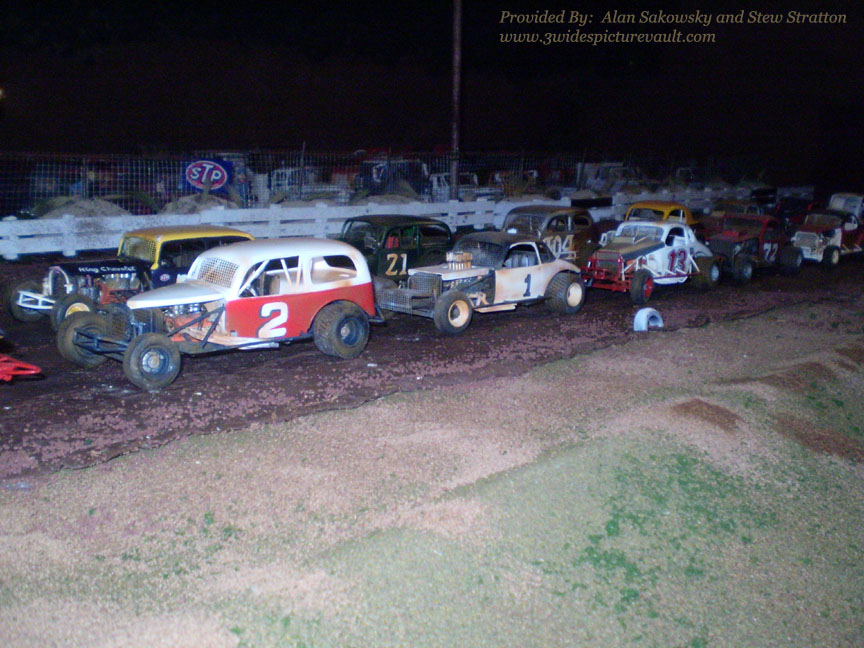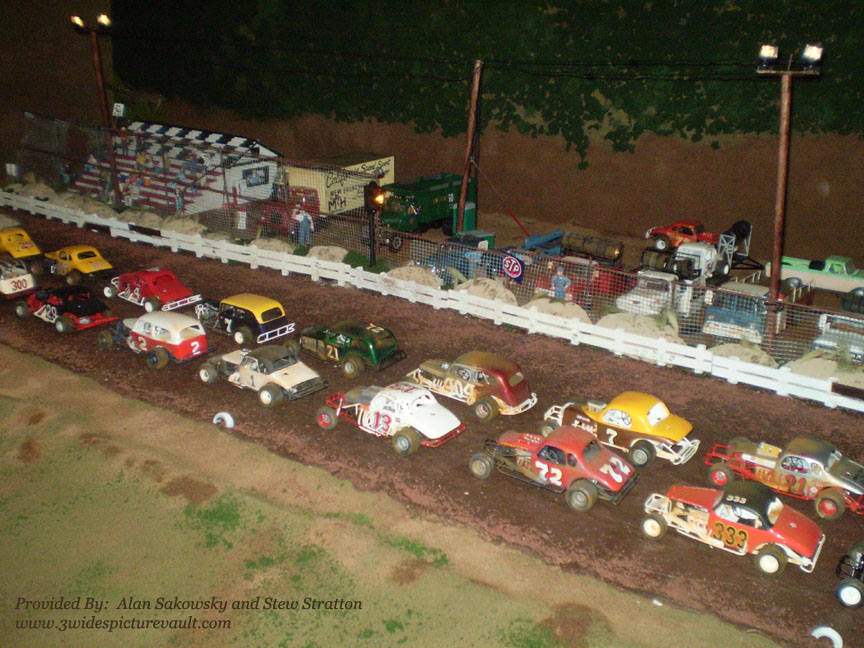East Windsor Speedway "Fast One" Trivia Answer:
The reason we called it "Fast One Trivia" is we were trying to pull a fast one...
Many of you correctely identified Frankie Schneider #2, Danny Mitchell #1, Lee Hendrickson #Z1, Joe Kelly #13, Phil Gemendon #404, Pee Wee Griffin #72, Leon Manchester #7 and Billie Osmun #333... But some of you may be surprised to know that the cars pictured below:

are not real...

They are from a diorama created by long time East Windsor Speedway fan Alan Sakowsky and modeler Stew Stratton.


Click Here
for a Friday Night Trip Back To East Windsor Speedway - 1970
The
Story of the 1970 East Windsor Speedway Diorama
From Alan Sakowsky
The 1/25th scale diorama most closely represents the early 1970 season at EWS that would have taken place on a Friday night lining up on the back-stretch for the feature race. There are 24 cars in the lineup. I think that was the number that normally ran. Research was done to build cars that actually ran Windsor during that time frame using 1970 AARN papers, pictorials and the 3-wide web site. We not only wanted to get the cars right, but also the surrounding details as well .
About 4 years ago I stumbled across your web site and viewing the pictures on it re-triggered thousands of memories I had going to East Windsor Speedway with my Father (and others like Langhorne) starting in the late 1960s and into the 1970s .
Shortly afterward, I started to collect old local racing memorabilia and subsequently purchased the Al Tasnady #39 car and racing hauler models from Stew Stratton of Greensboro, North Carolina. Subsequently, Stew began building replicas of cars for me. Stew was already an active follower of your web-site and was a die-hard spectator at Reading from the mid-1960s through the end. 'Back in the day', Stew would draw pictures of these cars and also build models of them as a youth. He spent many hours after the races in the pits talking to the drivers, mechanics and builders about their cars.
Most of the early models Stew built for me were cars that raced at the Langhorne Race of Champions from 1969-71. Shortly afterwards, I started to have him build cars that raced at Windsor in 1969-70 to further 'recapture my youth' . A friend of mine suggested building a diorama to display them. The back stretch at East Windsor speedway presents a good topic from several different fronts: it allows a stretch of the track/infield to be displayed with the cars; EWS has its own mini grandstand and pit house which was a more simple structure for me to build as my first project; and it allows the pit area with its unique activities along with Stew's haulers to be displayed .
I then decided that I wanted to build a complete field - one that would represent not only the top 10 drivers but those drivers who week in and week out came to do battle - Len Martin, Jack Moshera, Phil Gemenden, Charlie Shire, Leon Manchester etc. Without these 'little' guys, a 1970 field would not be real or as great.
All of the cars are 'scratch-builds'. For the 1936/37 Chevy coupes, the shells of the cars come from a 1937 Chevy AMT kit (Stew would modify the shell for the '36 coupe). For some of the sedans, we purchased the shells from Larry Baisch from near the Reading area who casts a whole host of resin shells for modified race cars for model builders. Stew will then sculpt and cut the shell to the actual 'cut' that makes each of these cars
unique. The hoods are all scratch built from styrene plastic to represent the actual car as close as possible (the rounded hoods present the biggest challenge). The suspensions, frame, rollcage, engine housing, side rails,
front and rear bumpers are all scratch built to model the real car as closely as possible. Whether a car ran a big block fuel injection or a small block carburetor it was modeled that way. Appropriate tire rims are used. Rubber tires actually have hand cut grooves. Engine wires and coils are present. t These cars all have moveable front ends with working linkage . Each car is distinct as they actually were back then- The uniqueness between each race car is the one point Stew and I want the viewer to walk away with. . I leave Stew to elaborate about the details if he so wishes as he is the artist and is much more technical than I am.
The painting and weathering were done by Stew. Most of the cars are hand numbered and lettered by Stew although a few are decaled. We wanted the 'dust effect' on these vehicles to actually represent a car that was starting the modified feature event late in the evening.
The haulers, M&H tire truck, and jeep are also largely scratch builds with detailed undercarriages and engine compartments. The backs of these vehicles are all scratch built from styrene plastic. Most represent real vehicles used at that time frame. To build many of these vehicles, 'kit bashing' was done. Some of the Ford cabs from the 1960s are not available as re-issued kits today. We actually had to purchase new old stock unbuilt pickup kits from 35-40 years ago to 'kit bash'. The undercarriage was extended by Stew for these long-framed haulers. In many cases, special tires are used and the suspension is altered to 'look right' for a large truck. Again, Stew can provide better details/clarity as he is the builder.
The front bumper for the pace jeep is scratch built on to a WWII era jeep kit made by Iterie in the 1980s. The light bar too is also scratch built.
The side panel paint job done on the M&H tire hauler is all hand painted by Stew.
Interestingly, Stew and I have never met. Today, Stew lives in Greensboro, North Carolina and I in New Jersey. I would specify the car or hauler to be built providing pictures or referring to those on your website or others. If we didn't have any, Russ Dodge would come through. In building some cars, Stew got to discuss details with Ray Neary, Phil Gemenden and others talking specifics about their cars. This was one of the high points of the project - talking with the actual drivers..
The diorama is approximately 10 feet long by 6 feet wide. The infield portion is actually a heavy train layout paper propped up by small 1 by 2 boards underneath. It folds down to provide access to the rest of the diorama. The backdrop is also this heavy paper supported by a wooden frame where I glued artificial foliage available at toy train shops. Many of the small accessories like people, dumpsters, the soda-machine, welding torches, spot-a-pot and the people are 1-25 th scale (also known as G-scale) that generally cater to the world of outdoor garden-trains. These accessories are available at train-shops and on the web. Most of the people were already painted. A couple were painted by me and altered. .
The diorama base is plywood. The track surface is actually a modeling clay that I rolled into sheets and smoothed out the seems with my hands. The clay does not dry out and has remained tacky months later. The dirt and grass surfaces are glued on ballast available in shaker containers at toy train shops. Much of the materials and techniques used are the same used in creating train layouts. There exists a large industry and several magazines catering to the hobby of creating train layouts and these were consulted and used.
The building, grandstand and 2-plank fence were built out of sheets/ sticks of balsa and bass wood available at craft stores. They were cut with an X-Acto knife and glued together to create the scratch built structures. Pictures from the 3-wide web-site were vital to refresh my memory of what the pit-house building and its window placement looked like.
The mounds of sand behind the fence are made out of paper-mache with glued on sand colored ballast. I used picture wire to simulate the cable supporting the 2 blank fence from behind. The wire fence is a screen that I got from a roll at Home-Depo and subsequently painted with a rust colored paint to give it an aged effect. It is supported by 1/8 th inch cut metal rods also purchased at the hardware store.
The lights, traffic light and welding torch circuit are all modifications from accessories available for train layouts. The overhead track lights I attached to wooden dowels available at Home-Depo and stained them to look like telephone poles. They are all connected to a train DC-transformer with accessory wire and are functional.. The welding torch will oscillate between white and blue to give it a realistic effect especially when the lights are dimmed.
For a special touch, in the infield I included a photographer to represent Ace Lane Sr. and a vintage 1966 Jo-Han kit Cadillac ambulance painted orange and white.
I wish I included both Tex Enright and Bill Singer but they are on the other side of the track!!!.
(Click pages 1, 2 & 3 below to view the entire diorama.)
East Windsor 1970 Diorama Photos
Page
1 -
2 -
3
Back to East Windsor Speedway Memories
Back To Homepage
Back
to Trivia Recap